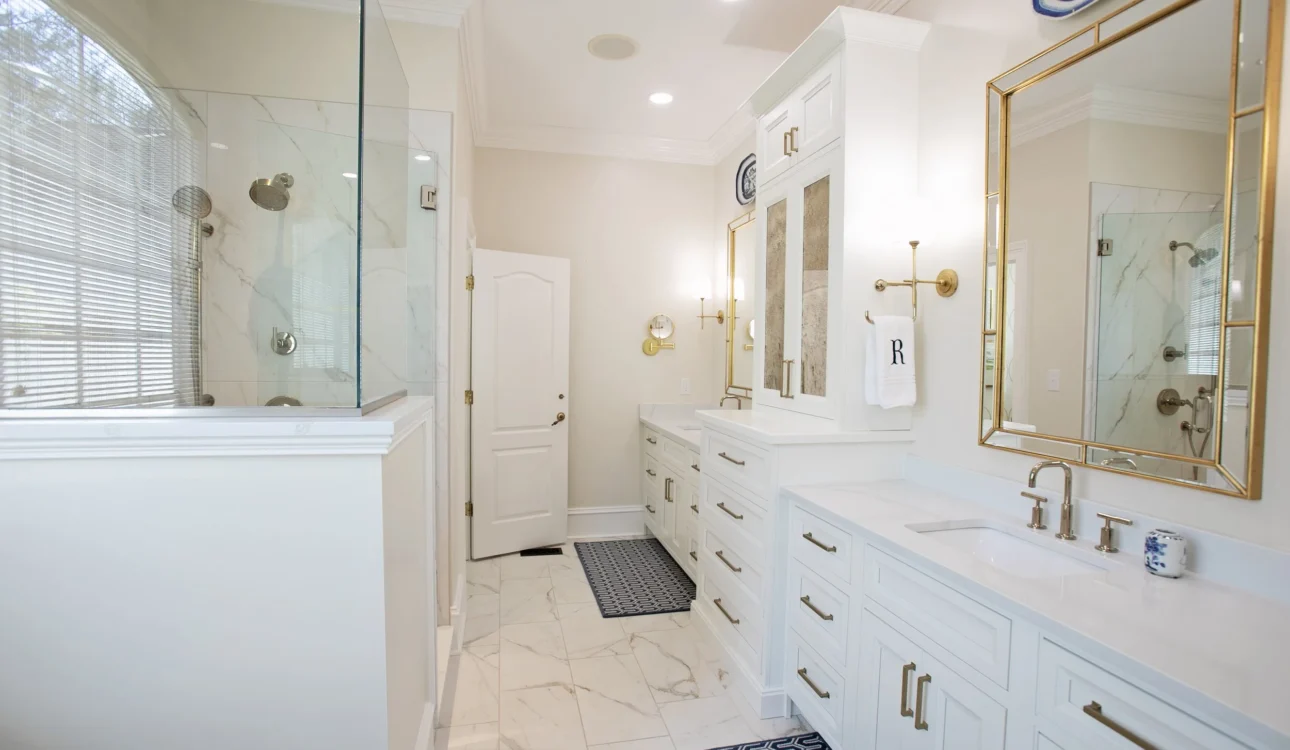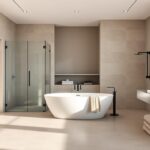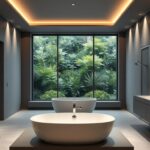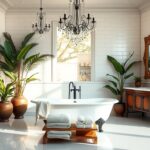We’ve all stood in that moment—staring at outdated tiles or a leaky faucet, wondering where to start. Home upgrades should feel exciting, not exhausting. If you’re in Chantilly, Ashburn, or nearby Northern Virginia communities, you know how quickly moisture and daily use can wear down surfaces. That’s why choosing the right elements matters more than you might think. Explore the Best Materials for Bathroom Remodel to ensure your space looks beautiful and lasts for years to come.
Renovating a space used daily by your family requires careful planning. Will that sleek countertop handle steam from hot showers? Can your flooring resist water damage for years? These questions aren’t just about style—they’re about creating a room that works as hard as you do. Our team has seen firsthand how the wrong choices lead to frustration, while smart selections bring lasting joy.
This guide cuts through the noise. We’ll walk you through durable surfaces, moisture-resistant options, and designs that boost your home’s value. Whether you’re in Fairfax’s historic neighborhoods or Reston’s modern townhomes, our insights match the unique needs of local homeowners. Let’s build a space that feels uniquely yours—without the guesswork.
Key Takeaways
- Prioritize durability and moisture resistance for surfaces exposed to daily use
- Balance aesthetic preferences with practical maintenance requirements
- Consider regional climate factors specific to Northern Virginia homes
- Leverage professional insights to avoid costly renovation mistakes
- Select options that enhance both functionality and property value
Understanding the Importance of Quality Materials in Bathroom Renovation
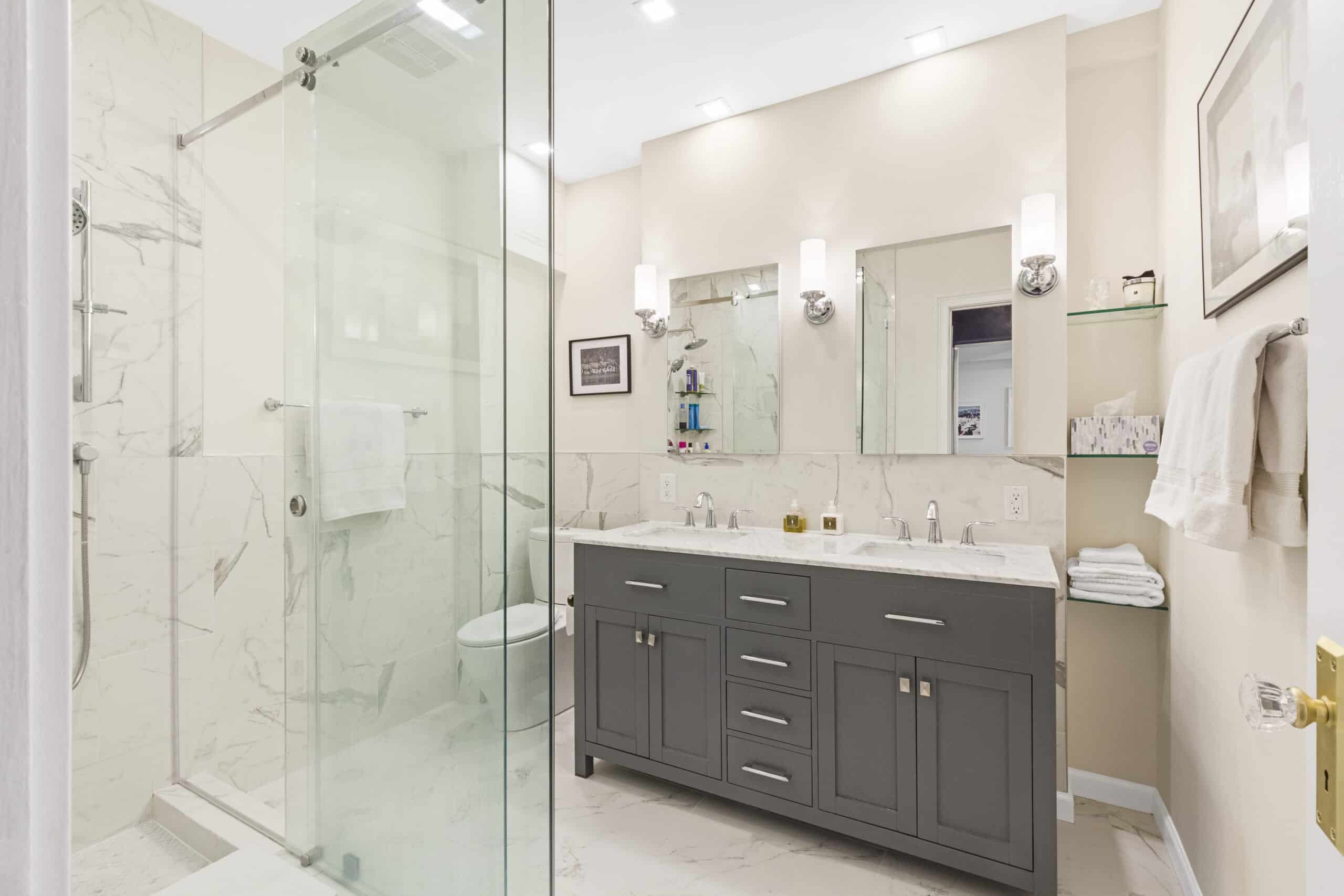
The foundation of any successful home upgrade lies in the decisions made before the first tile is laid. In moisture-prone spaces, every surface faces daily challenges – from steamy showers to accidental spills. That’s where smart planning meets smart solutions.
Impact on Durability and Long-Term Value
Northern Virginia’s humidity demands surfaces that laugh at condensation. We’ve seen ceramic tiles last decades in local homes, while cheaper alternatives warp within years. Proper waterproofing prevents mold growth behind walls – a hidden threat that can triple repair costs if ignored.
Our clients often discover their flooring choices affect resale value. A cracked grout line or stained vanity top tells buyers “future project.” But quartz counters and porcelain tiles? They whisper “move-in ready.”
Design and Maintenance Considerations
Today’s trends favor clean lines and natural textures. The good news? Many low-maintenance options mimic high-end looks without constant scrubbing. Large-format tiles reduce grout lines, while matte finishes hide water spots better than glossy surfaces.
We help homeowners balance style with practicality. That marble-look vinyl? It’s softer underfoot than ceramic and resists chips. Our Chantilly team shares local insights – like which sealants handle seasonal humidity swings – to keep your space stunning year-round.
Tips for Choosing the Best Materials for Bathroom Remodel
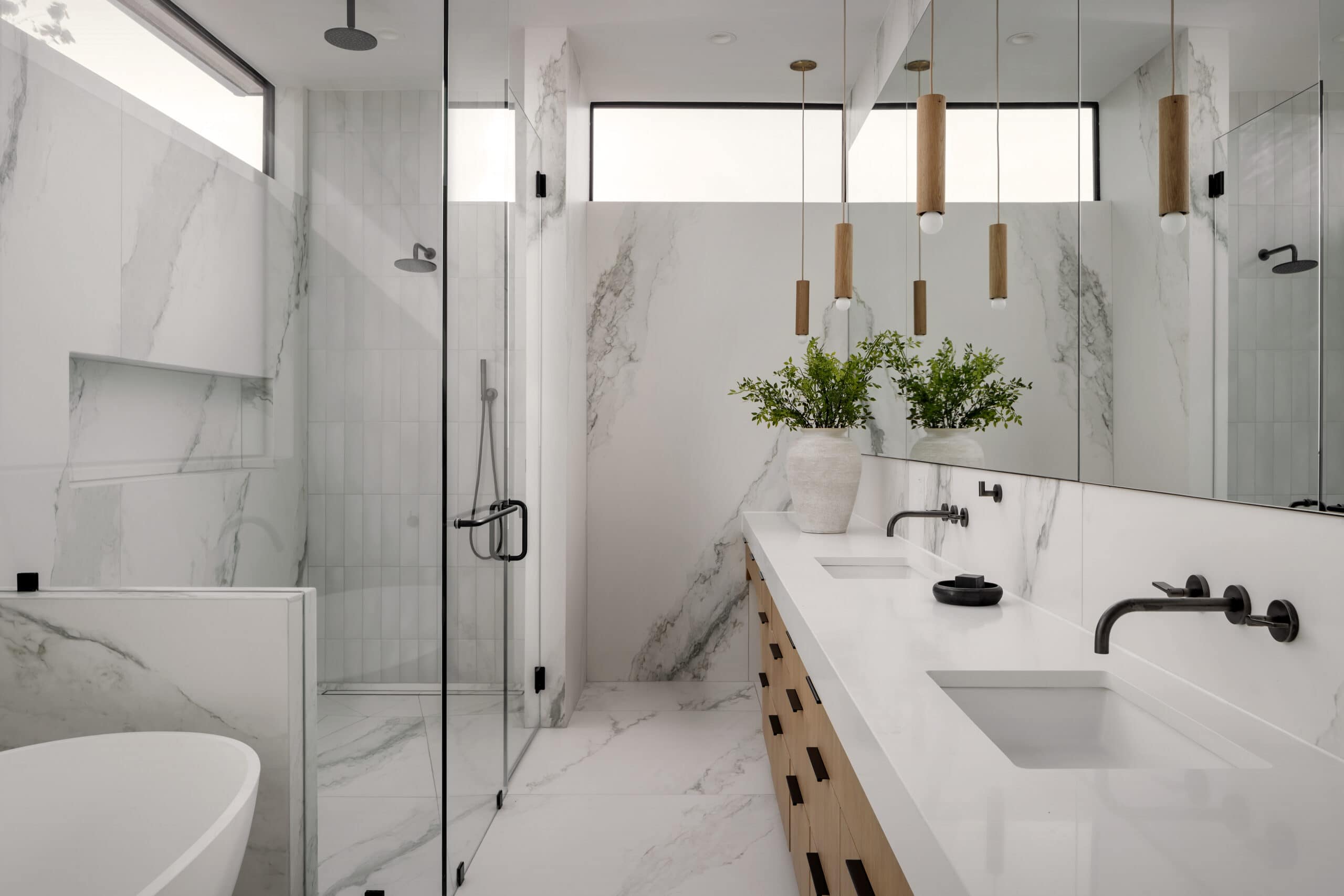
Navigating your renovation project starts with smart choices that stand up to daily life. We always begin by inspecting walls and subfloors – hidden water damage in older Chantilly homes often surprises homeowners. Proper prep work saves headaches later.
Create a budget that balances showstopper features with unseen essentials. That gorgeous vanity top shouldn’t eat funds needed for mold-resistant drywall. Our team helps allocate resources where they matter most – like waterproof membranes behind shower walls.
Focus on high-impact zones first. Porcelain tile near showers handles humidity better than most “trendy” alternatives. Engineered quartz offers stone’s elegance without constant sealing. We’ve seen these options thrive in Reston’s muggy summers and Ashburn’s chilly winters.
Ask about maintenance before committing. Some surfaces need weekly treatments, others just a quick wipe. Bring samples home – morning light in Fairfax Colonial windows reveals true colors better than store lighting.
Local expertise makes all the difference. Northern Virginia’s unique climate demands specific sealants and ventilation strategies. We’ll help you make sure every choice works harmoniously in your space for years to come.
Evaluating Tile Options: Ceramic, Porcelain, and Natural Stone
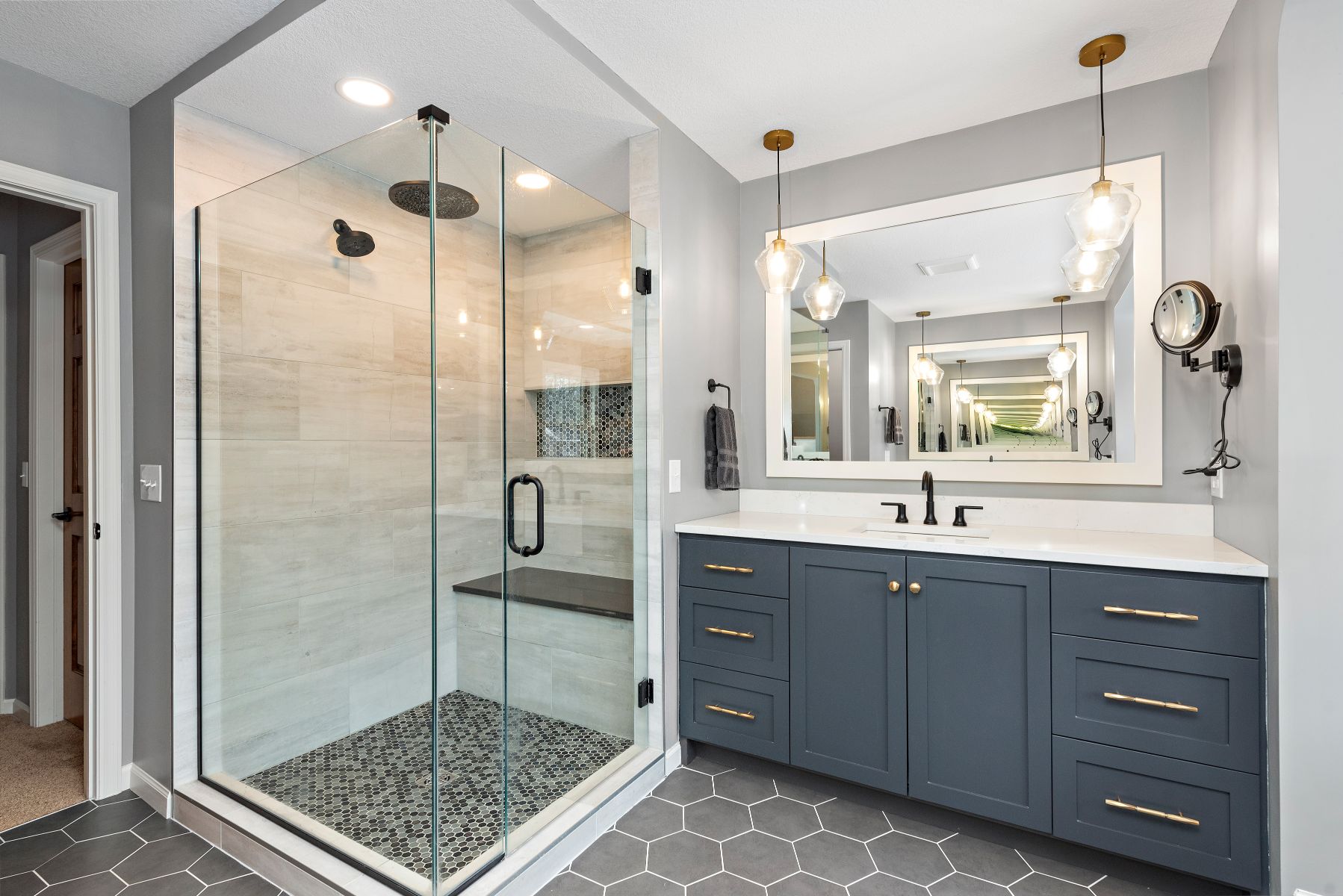
Chantilly homeowners face unique decisions when selecting surfaces that balance beauty and resilience. Our humid summers and occasional freeze-thaw cycles demand tiles that perform as beautifully as they look. Let’s explore how different options stack up in real-life Northern Virginia homes.
Comparative Benefits and Practicality
Ceramic remains a favorite for budget-friendly projects. Its water resistance handles everyday splashes, and modern printing techniques create wood-look planks or stone-inspired textures. But porcelain outshines it in wet zones – showers and floors stay safer with its near-zero absorption rate.
Natural stone like marble brings luxury but demands commitment. We’ve seen stunning Ashburn bathrooms where homeowners embrace weekly sealing routines. Mosaic patterns add grip to shower floors through extra grout lines, though cleaning those narrow spaces requires diligence.
Visual Appeal and Cleaning Ease
Matte finishes hide water spots better than glossy surfaces, a practical choice for busy families. Large-format porcelain tiles create seamless looks with minimal grout – perfect for contemporary Reston condos. Our tile selection guide shows how ceramic mimics travertine without the upkeep.
Remember: Proper sealing determines long-term success. We use epoxy grout in high-moisture areas to prevent discoloration. Whether you’re drawn to marble’s veining or porcelain’s practicality, we’ll help your choices stay stunning through Chantilly’s humidity swings.
Enhancing Waterproofing and Ventilation in Your Bathroom
Ever notice how steam clings to mirrors long after your shower ends? That lingering moisture isn’t just annoying – it’s a silent threat to your walls and floors. In Virginia’s climate, where humidity averages 70% in summer, smart moisture control makes or breaks renovations.
Building Fort Knox for Water Resistance
We start every project with KERDI-BOARD – our secret weapon against leaks. This waterproof substrate creates an impenetrable shield behind tiles, meeting strict local building codes for wet areas. Silicone-based caulk seals joints where walls meet showers, flexing with temperature changes without cracking.
Our layered approach includes vapor barriers under floors and membranes around drains. One Fairfax homeowner learned the hard way when skipped steps led to mold in their subfloor. Now, their new bathroom uses three moisture barriers – because one layer rarely suffices in our region.
Fresh Air Strategies That Actually Work
Ventilation isn’t just about noise levels. We install exhaust fans moving 100 CFM (cubic feet per minute) for standard bathrooms – more for spacious master suites. Proper duct routing matters too; venting into attics violates Virginia codes and invites mold parties.
Operable windows help, but can’t replace mechanical systems during sticky July days. We recommend timer switches that keep fans running 30 minutes post-shower. Pair this with mold-resistant drywall, and you’ve got a space that breathes easy year-round.
Remember: Humidity sensors and ENERGY STAR® fans optimize performance. Your towels will dry faster, and your grout lines stay cleaner. It’s how we help Chantilly homes stay fresh without constant upkeep.
Selecting Durable Subfloors and Underlayment Solutions
Many Chantilly homes whisper stories through their creaky floors—stories we help rewrite with solid foundations. Older properties often hide uneven surfaces beneath worn linoleum or cracked tiles. These hidden challenges demand solutions that blend precision with proven moisture control.
Importance of Leveling and Moisture Barrier Considerations
A perfectly flat surface isn’t just nice-to-have—it’s non-negotiable. We’ve rescued countless projects where dips caused tiles to crack within months. Our secret? Sika L-125 Floor Self-Leveler creates glass-smooth bases, eliminating future headaches from shifting floors.
Preparation starts with forensic-level inspections. We hunt for soft spots in subfloors—common in pre-1980s homes near Fairfax. Rotted plywood gets replaced before applying waterproof membranes. This dual approach stops moisture from creeping into vulnerable areas.
Local climate adds urgency. Summer humidity here tests every layer. Our team uses vapor barriers rated for Virginia’s muggy extremes. Pair this with properly sloped floors, and you’ll never see puddles linger after showers.
Remember: What’s beneath matters as much as what’s visible. We build foundations that handle decades of steamy mornings and muddy boots—because your bathroom should age gracefully, just like Chantilly’s historic charm.
FAQ
How do ceramic and porcelain differ in bathroom applications?
Ceramic tiles are affordable and versatile, ideal for walls and low-traffic floors. Porcelain, denser and less porous, handles heavy foot traffic better. Both resist water, but porcelain’s durability makes it a top pick for showers and high-use spaces.
What waterproofing steps prevent long-term damage?
Start with a moisture barrier beneath floors or behind walls. Use waterproof membranes like Schluter Systems in showers. Seal grout lines annually and opt for mold-resistant caulk around fixtures. Proper slope and drainage in showers also prevent pooling.
Can we incorporate wood accents without risking water damage?
Yes! Teak or sealed bamboo works well for vanities or shelving. Avoid direct water exposure—use wood-look porcelain tiles for floors or walls. Regular sealing and quick spill cleanup keep natural wood elements looking fresh.
How important is ventilation in protecting finishes?
Critical. High-quality exhaust fans (measured in CFM) remove steam quickly, preventing mold on grout and walls. Pair with operable windows for cross-breezes. We recommend timer switches to ensure fans run long enough post-shower.
What underlayment works best under bathroom floors?
Cement backer board provides stability for tile installations. For vinyl or laminate, use closed-cell foam underlayment with vapor barriers. Always check for level subfloors—self-leveling compounds fix minor dips before installing finished surfaces.
Are matte finishes practical for shower walls?
Matte tiles hide water spots better than glossy ones, making them low-maintenance. Choose textured options for slip resistance. Pair with epoxy grout to minimize staining, especially in hard-water areas like Chantilly.
How often should natural stone be resealed?
Most marble or travertine needs resealing every 6–12 months, depending on use. Perform a water droplet test—if it soaks in quickly, it’s time. Use pH-neutral cleaners to preserve sealants and avoid etching on delicate surfaces.
